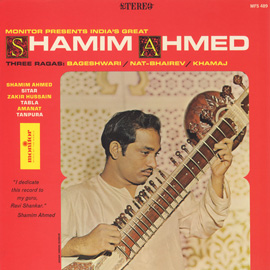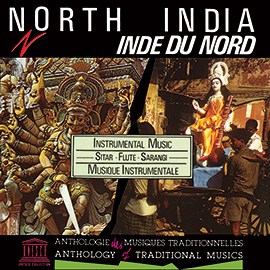Summary
Students will experience traditional Indian music and internalize it by moving to it. There will be an opportunity to listen to, play and dance to sitar music and ragas.
Suggested Grade Levels: 4-5, 6-8, 9-12
Country: India
Region: Asia
Culture Group: Indian
Genre: Indian Classical
Instruments: Sitar
Language: Hindi
Co-Curricular Areas: Social Studies, Dance
National Standards: 2, 4, 5, 6, 8
Prerequisites: A working knowledge of solfege and instrumental sight-reading ability.
Objectives:
- Experience Indian music by feeling the pulse
- Learn about the sitar by listening to a raga
- Gain an understanding and feel for playing Indian Music
Material:
- Recording of “Aalap and Dhrupad in Rag Bhairavi,” performed by Nirmalya Dey from Dhrupad (ARCE00018_104)
- “Bageshwari” by Shamim Ahmed from India's Great Shamim Ahmed: Three Ragas (MON00489_101)
- Diagram of Sitar
- “Omkaaraaya Namaha,” by Ravi Shankar
Lesson Segments:
- Listening and Moving to Indian Music (National Standards 6, 8)
- Understanding Sitar Through a Raga (National Standards 6)
- Playing Music from India (National Standards 2, 4, 5)
Lesson Segment #1: Listening and Moving to Indian Music

“Aalap and Dhrupad in Rag Bhairavi”
from Dhrupad | ARCE00018
Procedure:
- Play recording of “ Aalap and Dhrupad in Rag Bhairavi” and then ask questions:
- What part of the world is this music from?
- What kind of mood does it invoke?
- Is it in Western tuning?
- Ask students to partner up, and to choose a leader and a follower (they'll eventually trade roles).
- Play the recording again, and the leader will interpret the music through body movements, and the follower will mirror the leader.
- Leaders and followers trade roles, and play the recording one more time.
Assessment:
- Are the students making appropriate body movements with the music?
Lesson Segment #2. Understanding the Sitar Through a Raga

“Bageshwari”
from India's Great Shamim Ahmed: Three Ragas | MON00489
Procedure:
- Ask the following questions before the first listen of “Bageshwari”: What part of the world is this music from?
- What instrument is being played?
- Ask students the following questions after listening for the first time:
- What might the instrument look like / what is it made of?
- What causes the instrument to make the sound?
- After second Listening, talk briefly about how ragas are improvised.
- Each raga is in a different tonal mode.
- It is based on one motif/melody and then expanded upon.
- Show diagram of Sitar.
- Explain the basic structure of the sitar.
- Explain the basic structure of the sitar.
- Each string has its own tuning peg.
- The bridges connect their respective strings to the main gourd.
- The gourds act as resonators, to help project the sound
Assessment:
- Are the students discussing the raga? Are they engaged in learning about the sitar?
Lesson Segment #3. Playing Music from India
Procedure:
- Hand out parts to “Omkaaraaya Namaha”, and rehearse each as necessary.
- What instrument is being played?
- Refer to Lesson Segment 2, and explain that by layering the motifs the students have in front of them, they'll be improvising an Indian song.
- Perform the piece.
- Place students in small groups (not necessarily by instrument, but it would be easier for younger players); each group is responsible for playing one of the motifs.
- This arrangement of the piece is based on layering; bring in drones first, and then stack other motifs in; experiment with different instrument/layering combinations.
- To take it another step further, have the students dictate when to come in with their motifs themselves.
Assessment:
- Did the students play an arrangement of the piece? Were they able to improvise when to come in when layering?







